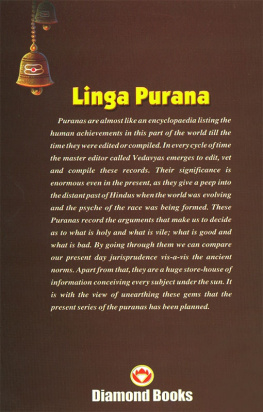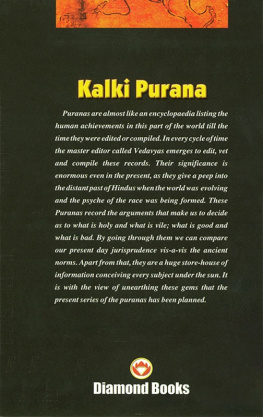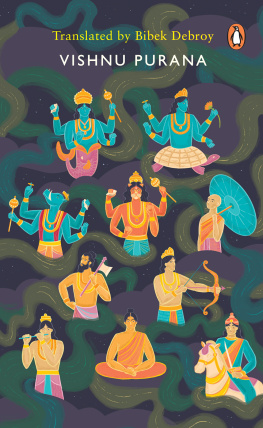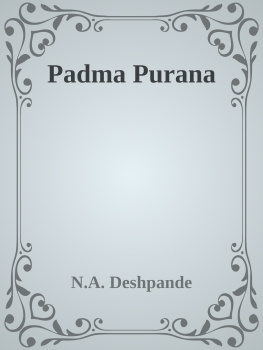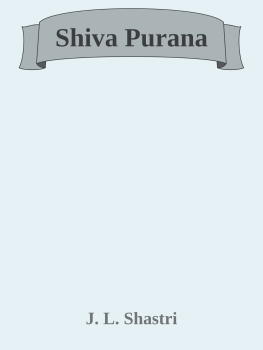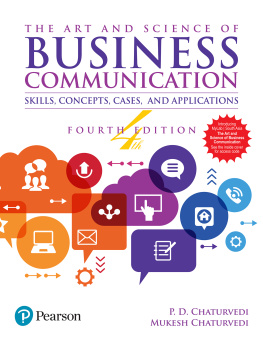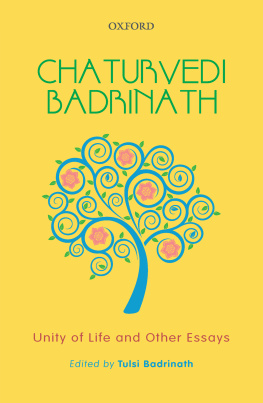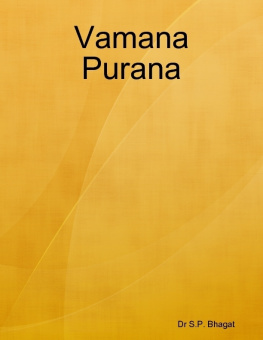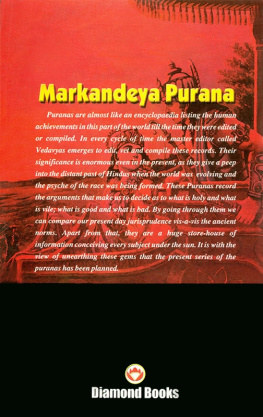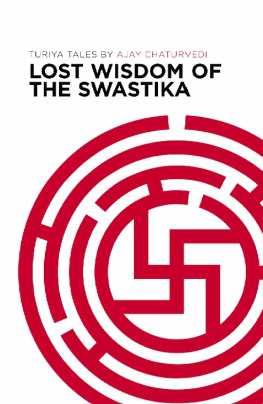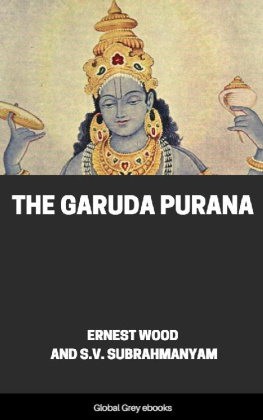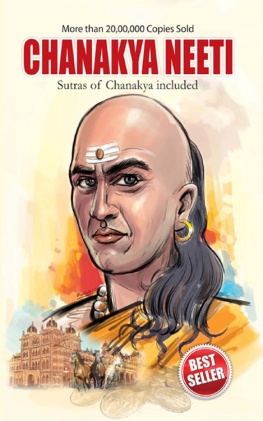B.K. Chaturvedi - Linga Purana
Here you can read online B.K. Chaturvedi - Linga Purana full text of the book (entire story) in english for free. Download pdf and epub, get meaning, cover and reviews about this ebook. publisher: Diamond Pocket Books (P) Ltd., genre: Religion. Description of the work, (preface) as well as reviews are available. Best literature library LitArk.com created for fans of good reading and offers a wide selection of genres:
Romance novel
Science fiction
Adventure
Detective
Science
History
Home and family
Prose
Art
Politics
Computer
Non-fiction
Religion
Business
Children
Humor
Choose a favorite category and find really read worthwhile books. Enjoy immersion in the world of imagination, feel the emotions of the characters or learn something new for yourself, make an fascinating discovery.
- Book:Linga Purana
- Author:
- Publisher:Diamond Pocket Books (P) Ltd.
- Genre:
- Rating:5 / 5
- Favourites:Add to favourites
- Your mark:
- 100
- 1
- 2
- 3
- 4
- 5
Linga Purana: summary, description and annotation
We offer to read an annotation, description, summary or preface (depends on what the author of the book "Linga Purana" wrote himself). If you haven't found the necessary information about the book — write in the comments, we will try to find it.
Linga Purana — read online for free the complete book (whole text) full work
Below is the text of the book, divided by pages. System saving the place of the last page read, allows you to conveniently read the book "Linga Purana" online for free, without having to search again every time where you left off. Put a bookmark, and you can go to the page where you finished reading at any time.
Font size:
Interval:
Bookmark:
In the list of the eighteen Mahapuranas, the Linga Purana is invariably listed as number eleven. But it does not mean that the Linga Purana was eleventh in the order of composition. There are many rituals in the text and these tend to indicate that the Linga Purana was composed much earlier because it contains many legends and stories that date back to much hoary a period. Even though the Linga Purana doesnt conform strictly to the conditions laid down for a Purana to be a Mahapurana, it is, indeed, considered a Mahapurana. It gives the details of Shiva-pooja and Yoga etc. in a most elaborate manner, not found even in the Shiva Purana. It is considered to be a Tamasika Purana. It is divided into two partsthe first part is said to be Poorva Bhaga and the other, Uttara Bhaga. There are one hundred and eighty chapters (Adhyaya) in the first part and fifty five in the subsequent part.

eISBN : 978-81-2882-279-7
Publisher
Published by : Diamond Pocket Books Pvt. Ltd.
X-30, Okhla Industrial Area, Phase-II New Delhi-110020
Phone : 011-41611861-65, 40712100
Fax : 011-41611866
E-mail : sales@dpb.in
Website : www.dpb.in
Edition : 2014
LINGA PURANA
by : B.K. Chaturvedi
In the list of the eighteen Mahapuranas, the Linga Purana is invariably listed as number eleven. But it does not mean that the Linga Purana was eleventh in the order of composition. There are many rituals in the text and these tend to indicate that the Linga Purana was composed much earlier because it contains many legends and stories that date back to much hoary a period. Even though the Linga Purana doesnt conform strictly to the conditions laid down for a Purana to be a Mahapurana, it is, indeed, considered a Mahapurana. It gives the details of Shiva- pooja and Yoga etc. in a most elaborate manner, not found even in the Shiva Purana. It is considered to be a Tamasika Purana. It is divided into two partsthe first part is said to be Poorva Bhaga and the other, Uttara Bhaga. There are one hundred and eighty chapters (Adhyaya) in the first part and fifty five in the subsequent part.
However, the language of the Purana is quite difficult and the style is rather convoluted. The composition is not as skilled as in the case of many other Puranas. The sentences are much long-winded, and hence the comprehension becomes relatively more difficult. At many places the legends are only referred to in passing reference and that, too, quite repeatedly. In order to present this work is an easy-to-understand and comprehensible language, we have taken recourse to many other Puranas (of the same series) so as to complete the story or the legend. When the legends become repetitive and are well known otherwise, we have even skipped the full story after barely touching the theme of the story. Sometimes after giving the full story the basic idea behind that legend has been given in the marked foot-notes. It has been done precisely for two reasons: One, to make the comprehension logical and second to abridge the ritualistic details which may hinder the stream of thought. The attempt is to give a brief but comprehensive glimpse into this Purana to our curious readersbred and brought up in a computer-logic based atmosphere.
It is earnestly hoped that this version of the Linga Puranarendered into English after consulting many of its versions appearing in the originalwould reveal the full idea behind this symbol-worship. Lastly the writer of this work wishes to share his gratitude he feels for Shri Narendraji of Diamond Pocket Books whose enthusiasm to revive our culture known no bounds.
B.K. Chaturvedi
Our salutations to Brahma, the creator; Vishnu, the sustainer; and Shiva, the destroyer. We also pray to the sages Nara and Narayana and the goddess of learning Saraswati. We also pay our obeisance to Sage Vedavyasa who made all the sacred texts accessible to us. We are entitled to read the sacred prayers only after saying these prayers.
Once Sage Narada, travelling all over the cosmos and he said: Since thou, O Shiva, hast treated me with contempt in preferring the embrace of Parvati, your forms of worship shall be the Linga (phallus) and Yoni (vagina).]
He said that the Linga represented regenerative power of the world. It is believed to be the origin of all creations.
He said that the divine essence is known as the Brahman. In the very beginning Brahman was the only entity in the universe. There was nothing else. It was this Brahman who divided himself into three different parts called Brahma, Vishnu and Shiva. Brahma became the creator; Vishnu, the sustainer and Shiva, the destroyer.
In the very beginning there was only water in the universe. In the water a gigantic egg (Anda) appeared. Brahma emerged from this egg which also contained all the worlds that were likely to be created.
During Brahmas day, creation flourishes. But during his night there is destruction (Pralaya). When Brahma emerged out of the primordial egg, that constituted the original process of creation (Sarga). But following the process of destruction that takes place during Brahmas night, there is also a periodical process of recreation (Pratisarga). Maheshwara (Lord Shiva Supreme) is the ultimate authority to cause this formal process of Sarga and Pratisarga. The realms with their presiding deities, sages stay during the Sarga and get dissolved in the oblivion during Pratisarga.
According to the Linga Purana, the smallest unit of time is a nimesha which is equal to the time taken in blinking ones eyes. Fifteen nimeshas make one Kastha, 30 Kashtas one Kala Treta Yuga and Dwapar Yuga of five hundred years, that between Dwapar and Kali Yuga of three hundred years and between Kali Yuga and the new Satya Yuga of five hundred years. These intervening periods make two thousand years. Thus the total span of a Mahayuga is of 12000 divine years.
In terms of human years the Satya Yuga is of 1.440,000 years, Treta of 1,080,000 years, Dwapar of 7,20,000 years and Kali Yuga of 3,60,000. So this Yuga cycle is 3,600,000 human years long. Adding 7,20,000 years for the Sandhyamsha, a Mahayuga is actually of 4,320,000 human years long.
A Manvantara consists of a little over 71 Mahayugas which means that a Manvantara would be equal to 296,720,000 human years. In all there are actually 306,720,000 human years in a Manvantara.
One thousand Mahayugas make
When Brahmas one day ends, the entire universe and all the beings therein are destroyed. But the Super Deities, viz: Brahma, Vishnu, Shiva, remain intact as they are the initiations of the fresh creation. Each cycle starts when there is total darkness and water everywhere. Vishnu remains asleep on this water. [One epithet of Vishnu is Narayana which literally means one who has his abode in water. Impliedly Vishnu signifies life because where there is water there is lifeas 15 Corroborated by even the modern science.]
When Brahmas day dawns he begins the process of creation afresh.
In the present cycle Brahma first created three sons through three mental powers (psychic sons. Some accounts say he created four sons). Their names are Sanaka, Sanandana, Sanatan and Sanat-kumara. These were child sages as they started performing great penance right since their childhood. They are always depicted as children. But since they did nothing to enhance creation through the normal process, Brahma had to create another nine sons through his mental powers. Their names are Mareechi, Bhrigu, Angira, Pulastya, Pulaha, Kratu, Daksha, Atri and Vashishtha.
But since they did little to enhance the creation in the normal process, in order to ensure that creation progressed further, Brahma next divided his body into two halves. The male half was known as Swayambhoo Manu, the female half as Shataroopa. These two halves married and had two sons and two daughters. The names of the sons were Uttanapada and Priyavarta and that of the two daughters were Akuti and Prasuti.
Font size:
Interval:
Bookmark:
Similar books «Linga Purana»
Look at similar books to Linga Purana. We have selected literature similar in name and meaning in the hope of providing readers with more options to find new, interesting, not yet read works.
Discussion, reviews of the book Linga Purana and just readers' own opinions. Leave your comments, write what you think about the work, its meaning or the main characters. Specify what exactly you liked and what you didn't like, and why you think so.

